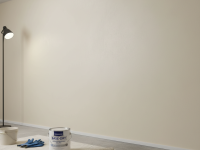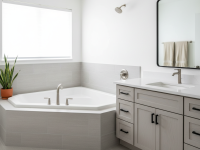Ever walked into a room and just thought, “Wow, this feels so… finished”? Chances are, that room had crown molding. It’s one of those architectural details that quietly elevates a space, adding a touch of classic elegance and making your walls feel taller and more substantial. For a long time, I looked at crown molding installation as one of those “professional-only” tasks, right up there with brain surgery or rocket science. The angles, the cuts, the precision – it all seemed incredibly daunting.
But then, curiosity (and a desire to save a ton of money on contractor fees) got the better of me. I decided to tackle a small bedroom, armed with a miter saw, a nail gun, and a healthy dose of YouTube tutorials. And guess what? It was challenging, absolutely. There were moments of frustration, certainly. But it was also incredibly rewarding, and completely, 100% doable for a begier. If I can do it, you absolutely can too!
This article isn’t just a list of instructions; it’s a peek into my own journey and the lessons I learned along the way. We’ll walk through everything from choosing your tools to making those infamous corner cuts, all in plain English, without making you feel like you need a carpentry degree. Let’s transform your space together!
Why Crown Molding? The Magic It Adds
Before we dive into the nitty-gritty, let’s talk about *why* you’d even want to bother with crown molding. It’s more than just a decorative strip of wood or MDF; it’s a design element that performs wonders:
- Adds Architectural Interest: It breaks up the stark line between your walls and ceiling, creating a visual flow and a more polished look.
- Increases Perceived Ceiling Height: This might sound counter-intuitive, but by drawing the eye upwards, crown molding can actually make your ceilings feel taller.
- Boosts Home Value: It’s a classic upgrade that often catches a buyer’s eye and can increase the aesthetic appeal and perceived value of your home.
- Hides Imperfections: Those tiny gaps or imperfections where your wall meets the ceiling? Crown molding is a fantastic camouflage artist.
From my own experience, the “after” is always so much more satisfying than I initially imagine. It’s like putting the perfect frame on a beautiful piece of art – it just completes the picture.
Tools of the Trade: What You’ll Absolutely Need (and a Few Nice-to-Haves)
Alright, let’s talk gear. Don’t worry, you don’t need a professional workshop, but having the right tools makes a *huge* difference in both ease and outcome. Here’s what I recommend:
Essential Tools:
- Miter Saw: This is your MVP. A good compound miter saw is crucial for making precise angle cuts. You can often rent one if you don’t want to buy, but if you plan on doing more DIY, it’s a worthy investment.
- Measuring Tape & Pencil: Obvious, but don’t skimp on a good, sturdy tape measure.
- Stud Finder: You’ll want to nail into studs for the most secure installation.
- Brad Nailer (or Finish Nailer): This is your second MVP. An electric or pneumatic nail gun (with an air compressor) will save you hours and give you a much cleaner finish than hammering by hand. Trust me on this one.
- Safety Glasses: Non-negotiable, especially when using a miter saw.
- Caulk Gun & Paintable Caulk: For filling those tiny gaps and making everything look seamless.
- Wood Filler/Spackle: For filling nail holes.
- Small Level: To ensure your molding is perfectly straight.
Nice-to-Haves (But Really Helpful):
- Coping Saw: For inside corners, some prefer coping over miter cuts. It has a steeper learning curve but can yield a tighter joint. We’ll discuss this more later.
- Angle Finder Tool: Can help determine exact wall angles, especially in older homes where corners might not be perfectly 90 degrees.
- Step Ladder/Stepladders: Plural, if you have a helper.
- Scrap Wood: Absolutely essential for practicing cuts. Do not skip this!
My first time, I tried to get away with a manual miter box. Big mistake. Save yourself the headache and invest in or rent a proper electric miter saw.
Measuring Up: The Golden Rule is ‘Measure Twice, Cut Once!’
This isn’t just a saying, it’s a sacred mantra in DIY crown molding. Seriously. You’ll thank me later. Here’s how to approach your measurements:
- Measure Each Wall Individually: Don’t assume anything. Walls are rarely perfectly square or the same length as their opposite.
- Add for Waste: Always buy about 10-15% more material than your initial linear footage calculation. You’ll make mistakes, you’ll have off-cuts, and you’ll want some extra for practice. It’s better to have too much than too little and have to run back to the store.
- Consider Piece Lengths: Crown molding typically comes in 8, 12, or 16-foot lengths. Plan your cuts so that seams (where two pieces join on a straight wall) are minimal and land on a stud if possible.
When I was measuring for my first room, I wrote down every single measurement on a sketch of the room layout. This visual aid helped me keep track of which cut went where and minimized confusion.
Tackling Corners: The Trickiest (But Not Impossible!) Part
Ah, corners. This is where most begiers (including past me!) get intimidated. But with a bit of understanding and practice, you’ll master them. Crown molding has a “spring angle,” meaning it sits at an angle between the wall and ceiling, not flush. This is key to understanding the cuts.
Inside Corners:
These are the most common. You have two main approaches:
- Mitered Joint: This involves cutting two pieces at opposing 45-degree angles (for a 90-degree corner) that meet flush. The downside? If your wall isn’t *exactly* 90 degrees (and most aren’t!), you’ll end up with a small gap.
- Coped Joint (Recommended for Begiers): This is a fantastic technique once you get the hang of it. You cut one piece of molding square into the corner. Then, for the second piece, you cut a 45-degree miter, and then use a coping saw (or jigsaw) to essentially trace and remove the back profile of the molding. This creates a “cope” that fits perfectly over the first piece, even if the wall isn’t square. It moves with the house and virtually eliminates gaps.
My first attempt at a coped joint felt like performing surgery, but after a few practice pieces, it clicked. It’s a more forgiving method for begier DIYers and yields a much tighter corner.
Outside Corners:
Less common but equally important. For these, you’ll cut two pieces with opposing bevels that essentially wrap around the outside of the corner. This is typically a compound miter cut (meaning both bevel and miter angles on your saw are used). Again, practice on scrap!
Cutting Your Crown: Setting Up Your Miter Saw Like a Pro
This is where the “upside down and backwards” method comes into play. Because crown molding sits at an angle, you can’t just lay it flat on your miter saw fence. You need to simulate its installed position. Here’s the trick:
- Flip It: Place the crown molding on your miter saw’s bed, but upside down. The edge that touches the ceiling will be against the saw’s fence, and the edge that touches the wall will be against the saw’s base.
- Secure It: Hold it firmly against both the fence and the base. You can even clamp it if your saw allows for extra security.
- Angles for a 90-degree Corner:
- Inside Corners: The miter saw will be set to a 45-degree miter angle. For the coped piece, you’ll cut a 45-degree miter (this is your guide for coping), and the other piece will be a straight 90-degree cut.
- Outside Corners: Typically, your miter saw will be set to a 45-degree miter angle AND a 45-degree bevel angle (or close to it, depending on your crown’s spring angle). It’s a compound cut.
- Test, Test, Test: Take small scrap pieces of molding and make your practice cuts. Hold them up to the actual corner. Adjust your saw’s angle a hair if needed. This step is non-negotiable!
I remember feeling like a contortionist trying to hold the molding just right for my first few cuts. It gets easier, I promise. The key is consistency in how you hold the molding against the fence and base.
Putting It All Together: Installation Day!
You’ve measured, you’ve cut, now it’s time to put it all up! This is where your hard work pays off.
- Start with a Long Wall: If possible, begin on your longest, most straightforward wall. This gives you confidence before tackling complex corners.
- Work Your Way Around: Install one piece at a time, fitting them tightly against the wall and ceiling.
- Nail into Studs: Use your stud finder to mark the stud locations on your wall and ceiling. Fire your brad nails into these spots for maximum hold. If there are no studs where you need a nail, angle your nails into the top and bottom plates (where the wall framing meets the ceiling and floor). Use enough nails to hold it securely, typically every 12-16 inches.
- Seams on Straight Runs: If you have to join two pieces on a long wall, use a “scarf joint.” This is where you cut both ends at opposing 45-degree angles, creating a long, overlapping joint that’s much less visible than a straight butt joint. Glue and nail this joint securely.
- Check for Level and Tightness: As you go, use your level to make sure the molding isn’t dipping or rising. Press it firmly against the wall and ceiling before nailing.
The first piece I installed was surprisingly easy because it was a straight run. It gave me the morale boost I needed to keep going for those tricky corners!
Finishing Touches: The Secret to a Professional Look
This is where your DIY project truly transforms into something that looks like it was done by a pro. Don’t skip these steps!
- Caulk Those Gaps: Even with the best cuts, there will be tiny gaps where the molding meets the wall and ceiling, and at the joints. Load up your caulk gun with paintable caulk and run a thin bead along all these seams. Smooth it out with a wet finger or a damp sponge for a perfectly seamless finish. This is magic, pure and simple.
- Fill Nail Holes: Apply a small dab of wood filler or spackle over every nail hole. Let it dry completely, then lightly sand it smooth with fine-grit sandpaper.
- Sand and Paint: Once all filler and caulk are dry, give the entire molding a light sanding, then wipe it clean. Now it’s ready for paint! Choose a paint color that complements your ceiling or wall for a truly custom look.
The caulking stage is incredibly satisfying. It’s like watching all the little imperfections disappear, revealing a beautifully integrated architectural feature.
You Can Do It!
My first crown molding project took me an entire weekend, involved a few muttered curses, and definitely more trips to the hardware store than I’d care to admit. But when I stepped back and looked at that finished room, painted and perfect, the sense of accomplishment was immense. It completely changed the feel of the space, and I did it myself!
Crown molding installation for begiers is a journey, not a sprint. Take your time, practice your cuts, and don’t be afraid to make mistakes – that’s how we learn. The satisfaction of adding such a beautiful, classic detail to your home with your own two hands is truly unparalleled. So, grab those tools, measure twice, and get ready to elevate your home!




